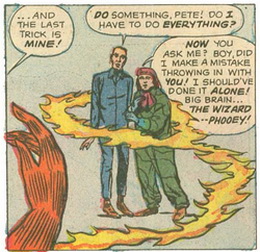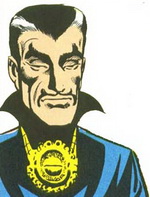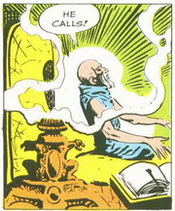
Published: July, 1963
Plot: Stan Lee
Script: H.E. Huntley
Art: Dick Ayers
Letters: John Duffy
“Dr. Strange Master of Black Magic!”
Script: Stan Lee
Art: Steve Ditko
Letters: Terry Szenics
There are two villains in the leading Torch story. Who can forget Paste Pot Pete? But I didn’t remember the Wizard when I met him here. I started to worry about my brain, but when I asked Russ, he assured me that the story where we first met the Wizard (Strange Tales #102) is not one of the most compelling tales in the Marvel Universe, so I had skipped over it. Way back, after my first Human Torch review, I realized that the Human Torch stories in Strange Tales were probably not going to be among my favorites, so I decided not to read and review any more.
Of course, having said all that, since then I’ve actually reviewed one or two. I guess there are always exceptions to the rule! And now, the obvious exception is the reappearance of Paste-Pot Pete! He’s such a ridiculous villain, I get such a kick out of him. In this story, I was kind of hoping I would once again hear him boldly proclaim, “Paste is the ultimate weapon!” but alas, in that I was disappointed.
And truthfully, I was fairly disappointed in this Torch story overall. Reading it cemented my decision to forego reading a whole lot of these Torch stories. Actually, there are only two comments I care to make about this story, and then I’ll move on to the real reason why I’m reviewing this book at all.
 1. Bickering villains. The Wizard is your standard egotistical egghead, and treats Paste-Pot Pete like a servant, to which Pete strongly objects. I kept waiting for the two of them to break out in full-fledged fisticuffs, but it didn’t happen. Still, we do manage a few amusing moments, such as when the Wizard is rattling on about their plan and Pete whines, “Do you always have to make a SPEECH when you do something?” Oh?? Like Pete himself has never made a speech? All good villains make speeches about what terrifically smart and awesome bad guys they are. And…it seems…so do some of the not-so-good villains…
1. Bickering villains. The Wizard is your standard egotistical egghead, and treats Paste-Pot Pete like a servant, to which Pete strongly objects. I kept waiting for the two of them to break out in full-fledged fisticuffs, but it didn’t happen. Still, we do manage a few amusing moments, such as when the Wizard is rattling on about their plan and Pete whines, “Do you always have to make a SPEECH when you do something?” Oh?? Like Pete himself has never made a speech? All good villains make speeches about what terrifically smart and awesome bad guys they are. And…it seems…so do some of the not-so-good villains…
2. Johnny the Wonder Teen. Once again, we see young Johnny Storm going for the gusto, not only engaging in good-deed doing as the Human Torch, but also hitting the books to study for a history exam, all the while enduring the scorn of fellow classmates who believe he is an enemy spy, because they read it in the newspaper, and as we all know, “Newspapers don’t print such accusations without evidence.” I thought that was pretty funny, but the punchline comes at the end of the story, when everyone thinks Johnny is such a lucky guy, while Johnny himself laments that having to deal with Paste-Pot Pete and the Wizard has left him very little time to study for his history exam. Superheroing, school, basketball, part-time job, I’m telling ya…that Johnny Storm had better stop burning the candle at both ends or he’s likely to BURN OUT.
 Now. Getting back to business…did I happen to mention what I was really here for? The second half of this book premieres, “quietly and without fanfare,” a new series, introducing a “different kind of super-hero,” the unparalleled mysticism of Dr. Strange, Master of Black Magic!
Now. Getting back to business…did I happen to mention what I was really here for? The second half of this book premieres, “quietly and without fanfare,” a new series, introducing a “different kind of super-hero,” the unparalleled mysticism of Dr. Strange, Master of Black Magic!
And what is so strange about Dr. Strange (besides his name, I mean)? Well, let me offer this brief synopsis, after which you can judge for yourself:
A mysterious man plagued by nightmares desperately seeks the help of one whose name is only “spoken in whispers—Dr. Strange!” Strange agrees to take his case, and enters his client’s dream as a “metaphysical spirit.” Here he meets a cloaked figure draped in chains, who reveals that the dreamer is an EVIL MAN.

In the evil man’s dream, Strange also meets his ancient foe, Nightmare, a shadowy figure atop a wild stallion. Threatened by Nightmare, as well as the dreamer, who has awakened and is now threatening the sleeping Strange with a gun, our hero calls out to his Master, an ancient Asian with powers that transcend time and space. By concentrating very, very hard, the Master activates the huge amulet hanging from Dr. Strange’s neck, and the hypnotic ray stops the shooter in his tracks.
In that split-second, Strange slips out of the dream, leaving Nightmare frustrated and threatening, as any good villain would, “You’ve eluded me THIS time, but I’ll get you YET!”
Back in the real world, the bad guy confesses to his crimes, and also to his stupidity in calling upon Dr. Strange in the first place. I mean, really! What did he think was going to happen by inviting a master of black magic into his dreams? This was strictly a case of “you get what you pay for.”
My theory: the evil dreamer wanted to be found out, forced into confession, so that he could at last get some rest. Well, if so, then Dr. Strange helped him, as any good superhero would.
But beyond that, as Stan warned us on the splash, Strange is indeed a very different kind of superhero. And I actually find it odd that he’s introduced in the same book where the Human Torch has an encounter with Paste-Pot Pete. How likely is it that readers who get a kick out of Paste-Pot Pete are going to latch on to a superhero like Dr. Strange?

 Who’s reading these comics in 1963, anyway? Still little boys with 12 cents? Do they really care if a magician with gray streaked hair and oversized jewelry metaphysically visits someone who looks like their grandpa, then conquers “all of time and space in its silent flight” to enter the world of nightmares?
Who’s reading these comics in 1963, anyway? Still little boys with 12 cents? Do they really care if a magician with gray streaked hair and oversized jewelry metaphysically visits someone who looks like their grandpa, then conquers “all of time and space in its silent flight” to enter the world of nightmares?
Well…yeah…
Okay. Gotta admit. Dr. Strange’s powers are kinda cool. Whether it’s little boys, or high school and college kids reading by this time, this new and very “different kind of super-hero” surely emerges as a breath of exotically fresh air in this world of thugs proclaiming nonsense like “Paste is the ultimate weapon!”
I’m not yet a student of Marvel Comics history, but if I had to guess, I would say the introduction of a hero the caliber of Dr. Strange indicates a maturing of the readership. This might also be one of the first indications that someday, Marvel Comics will be considered worthy of scholarly study.
Of course, if nothing else, it was probably a good sign at the time that the Marvel organization was willing to step out in faith with a new product, trusting that Dr. Strange’s audience would find him, either in the existing readership, or by word of mouth, or perhaps by…the working of Black Magic!!
I’ve read a few Dr. Strange stories after this first one. If you’ve been with me from the beginning, you know that when I started this blog, I had already made it to a certain point in my reading (somewhere around the summer of 1964), so right now, I’m still backtracking. Someday soon I hope to catch up with myself! And when I do, I wonder how my opinion of Dr. Strange will eventually settle down.
Because currently, my opinion is unsettled. From what I’ve read thus far, Dr. Strange stories have not been among my favorites. But in another way, because Strange is, indeed, so strange, and so different, I sometimes find myself enjoying the side trip to this unique province of the Marvelous Zone in which we encounter the wonders of the mystic arts.
![]() Well, Stan sure did give us something new and strange and different this time around, but don’t be surprised if all your old favorite tropes return for a bit of mischief next time we meet, here in the Marvelous Zone!
Well, Stan sure did give us something new and strange and different this time around, but don’t be surprised if all your old favorite tropes return for a bit of mischief next time we meet, here in the Marvelous Zone!
| Want to read this comic on your computer? Marvel has a scan! Want to own the Human Torch story? Buy the Masterworks! Want to own the Doctor Strange story? Buy the Masterworks! |














